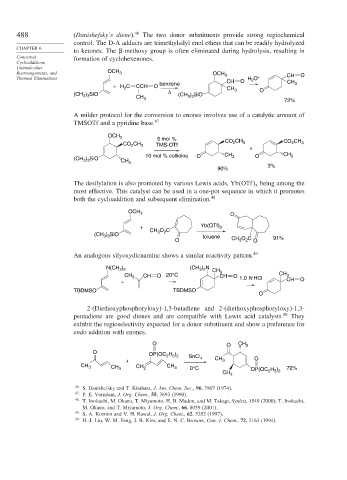Page 514 - Advanced Organic Chemistry Part B - Reactions & Synthesis
P. 514
488 (Danishefsky’s diene). 46 The two donor substituents provide strong regiochemical
control. The D-A adducts are trimethylsilyl enol ethers that can be readily hydrolyzed
CHAPTER 6
to ketones. The -methoxy group is often eliminated during hydrolysis, resulting in
Concerted formation of cyclohexenones.
Cycloadditions,
Unimolecular
Rearrangements, and OCH 3 OCH 3 CH O
Thermal Eliminations O H 2 O +
benzene CH CH 3
+H C CCH O CH
2
(CH ) SiO Δ (CH ) SiO 3 O
3 3
3 3
CH 3
72%
A milder protocol for the conversion to enones involves use of a catalytic amount of
TMSOTf and a pyridine base. 47
OCH 3
5 mol % CO CH
CO CH 3 TMS-OTf 2 3 CO 2 CH 3
2
+
10 mol % collidine O CH O CH 3
(CH ) SiO CH 3
3 3
3
3%
90%
The desilylation is also promoted by various Lewis acids, Yb OTf being among the
3
most effective. This catalyst can be used in a one-pot sequence in which it promotes
both the cycloaddition and subsequent elimination. 48
OCH 3
O
+ Yb(OTf) 3
2
CH 3 O C
) SiO
(CH 3 3 toluene
O CH O C O 91%
3
2
An analogous silyoxydienamine shows a similar reactivity pattern. 49
) (CH ) N
N(CH 3 2 3 2
CH 3
CH 3 CH O 20°C CH O CH 3
+ 1.0 N HCl CH O
TBDMSO TBDMSO
O
2-(Diethoxyphosphoryloxy)-1,3-butadiene and 2-(diethoxyphosphoryloxy)-1,3-
pentadiene are good dienes and are compatible with Lewis acid catalysts. 50 They
exhibit the regioselectivity expected for a donor substituent and show a preference for
endo addition with enones.
O O CH 3
O OP(OC H ) SnCl
2 5 2
+ 4 CH 3 O
CH 3 CH 3 CH 2 CH 3 0°C OP(OC H ) 72%
CH 3 2 5 2
46 S. Danishefsky and T. Kitahara, J. Am. Chem. Soc., 96, 7807 (1974).
47
P. E. Vorndam, J. Org. Chem., 55, 3693 (1990).
48 T. Inokuchi, M. Okano, T. Miyamoto, H. B. Madon, and M. Takagi, Synlett, 1549 (2000); T. Inokuchi,
M. Okano, and T. Miyamoto, J. Org. Chem., 66, 8059 (2001).
49 S. A. Kozmin and V. H. Rawal, J. Org. Chem., 62, 5252 (1997).
50
H.-J. Liu, W. M. Feng, J. B. Kim, and E. N. C. Browne, Can. J. Chem., 72, 2163 (1994).

